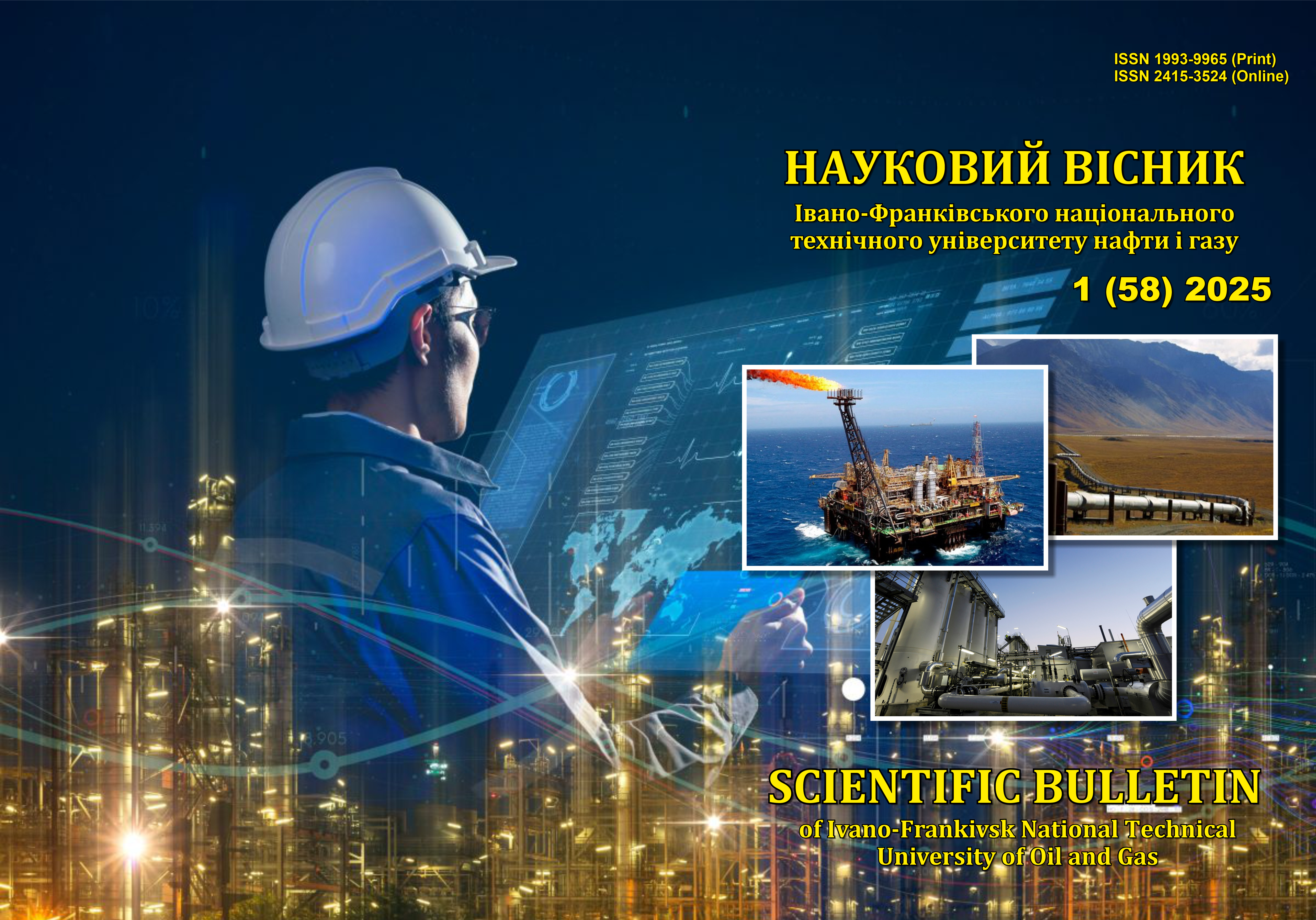ARTIFICIAL INTELLIGENCE AS A PART OF THE ANGULAR COMPONENT FRAMEWORK: AN EXAMPLE OF INTEGRATING
DOI:
https://doi.org/10.31471/1993-9965-2025-1(58)-108-123Keywords:
applied mechanics, machine learning, artificial intelligence, fracture mechanics, material science.Abstract
This paper presents an approach to the development of an intelligent web application for processing
ultrasonic non-destructive testing (NDT) data, utilizing the Angular component framework and the integration of deep learning models. The focus is on designing an architecture that supports real-time preprocessing, visualization, and interpretation of A-signals through a REST API. A review of modern machine learning architectures is provided, including convolutional autoencoders, convolutional and recurrent neural networks, transformer models, and attention mechanisms. Their effectiveness is analyzed in tasks such as signal denoising, automatic defect localization, time-of-flight (ToF) estimation, and diagnostic reliability enhancement. The study outlines the limitations of traditional rule-based approaches, which lack sufficient adaptability to noise, signal variability, and inspection conditions. Based on these findings, a system architecture is proposed, featuring modular interaction between an Angular client and a backend deep learning model implemented using PyTorch and FastAPI. A custom component, SignalDenoisingService, has been developed to handle input signal processing, transmit data as tensors to a REST-wrapped model, and display the processed results as visual plots. The autoencoder model was trained on a synthetic dataset of A-signals containing noisy pulses simulating defects, followed by accuracy testing of signal reconstruction. The proposed solution demonstrates high robustness to noise, an increase in signal-to-noise ratio (SNR) by 3–5 times, and scalability to new input signal types without modifying the client-side logic. Special emphasis is placed on ensuring explainability (XAI), traceability of decisions, automatic anomaly detection, and uncertainty feedback mechanisms. The study shows that the developed system can be integrated with autonomous robotic data acquisition platforms to enable advanced intelligent diagnostic systems. The results provide a foundation for the advancement of digital solutions in industrial inspection and technical monitoring using modern web technologies and artificial intelligence.
Downloads
References
Sambath S., Nagaraj P., Selvakumar N. Automatic defect classification in ultrasonic NDT using artificial intelligence. Journal of Nondestructive Evaluation. 2011. Vol. 30. P. 20–28.
Shrifan N.H.M.M., Akbar M.F., Isa N.A.M. Prospect of using artificial intelligence for microwave nondestructive testing technique: A review. IEEE Access. 2019. Vol. 7. P. 110628–110650.
Angiulli G., Scarcella G., Morabito F.C., Versaci M. Advances in the integration of artificial intelligence and ultrasonic techniques for monitoring concrete structures: A comprehensive review. Journal of Composites Science. 2024. Vol. 8, No. 12. Article 531.
Taheri H., Salimi Beni A. Artificial Intelligence, Machine Learning, and Smart Technologies for Nondestructive Evaluation. Handbook of Nondestructive Evaluation 4.0. 2025. P. 1–29.
Yella S., Dougherty M.S., Gupta N.K. Artificial intelligence techniques for the automatic interpretation of data from non-destructive testing. Insight – Non-Destructive Testing and Condition Monitoring. 2006. Vol. 48, No. 1. P. 10–20.
Cantero-Chinchilla S., Wilcox P.D., Croxford A.J. Deep learning in automated ultrasonic NDE: developments, axioms and opportunities. arXiv preprint arXiv: 2112.06650. 2021. 22 р. DOI: 10.48550/arXiv.2112.06650
Posilović L., Medak D., Subašić M., Budimir M., Lončarić S. Generative adversarial network with object detector discriminator for enhanced defect detection on ultrasonic B-scans. arXiv preprint arXiv: 2106.04281. 2021. 10 р. DOI: 10.48550/arXiv.2106.04281
Nakajima M., Saitoh T., Kato T. A study on deep CNN structures for defect detection from laser ultrasonic visualization testing images. arXiv preprint arXiv: 2305.18327. 2023. 12 р. DOI: 10.48550/arXiv.2305.18327
Pérez E., Ardic C.E., Çakıroğlu O., et al. Integrating AI in NDE: Techniques, Trends, and Further Directions. arXiv preprint arXiv: 2404.03449. 2024. 35 с. DOI: 10.48550/arXiv.2404.03449
LeCun Y., Bengio Y., Hinton G. Deep learning. Nature. 2015. Vol. 521, No. 7553. P. 436–444.
Krizhevsky A., Sutskever I., Hinton G. E. ImageNet classification with deep convolutional neural networks. Advances in Neural Information Processing Systems (NIPS). 2012. Vol. 25. P. 1097–1105.
Simonyan K., Zisserman A. Very deep convolutional networks for large-scale image recognition. International Conference on Learning Representations (ICLR). 2015. 13 p. [Electronic resource]. – Access mode: https://arxiv.org/abs/1409.1556
He K., Zhang X., Ren S., Sun J. Deep residual learning for image recognition. Proceedings of the IEEE Conference on Computer Vision and Pattern Recognition (CVPR). 2016. P. 770–778.
Szegedy C., Liu W., Jia Y., Sermanet P., Reed S., Anguelov D., Erhan D., Vanhoucke V., Rabinovich A. Going deeper with convolutions. Proceedings of the IEEE Conference on Computer Vision and Pattern Recognition (CVPR). 2015. P. 1–9.
Fawaz H. I., Forestier G., Weber J., Idoumghar L., Muller P. A. InceptionTime: Finding AlexNet for time series classification. Data Mining and Knowledge Discovery. 2020. Vol. 34, No. 6. P. 1936–1962.
Szegedy C., Ioffe S., Vanhoucke V., Alemi A. A. Inception-v4, Inception-ResNet and the impact of residual connections on learning. Proceedings of the AAAI Conference on Artificial Intelligence (AAAI). 2017. Vol. 31, No. 1. P. 4278–4284.
Huang G., Liu Z., Van Der Maaten L., Weinberger K. Q. Densely connected convolutional networks. Proceedings of the IEEE Conference on Computer Vision and Pattern Recognition (CVPR). 2017. P. 4700–4708.
Tan M., Pang R., Le Q. V. EfficientDet: Scalable and efficient object detection. Proceedings of the IEEE/CVF Conference on Computer Vision and Pattern Recognition (CVPR). 2020. P. 10781–10790.
Graves A. Supervised sequence labelling with recurrent neural networks. Springer, 2012. 143 p.
Hochreiter S., Schmidhuber J. Long short-term memory. Neural Computation. 1997. Vol. 9,
No. 8. P. 1735–1780.
Munir M., Siddiqui S. A., Dengel A., Ahmed S. A deep learning approach for ultrasonic signal denoising and defect classification. Ultrasonics. 2020. Vol. 108. Article 106219. https://doi.org/10.1016/j.ultras.2020.106219
Gao R., Yang X., Hou C., Zhao Y., Liu Y. A hybrid denoising method for ultrasonic signals using image-based autoencoders. Ultrasonics. 2021. Vol. 115. Article 106439. https://doi.org/10.1016/j.ultras.2021.106439
Cantero-Chinchilla S., Belahcene F., Holmes C., Velichko A., Wilcox P. CNN-based estimation of overlapping echoes and time-of-flight in ultrasonic signals. NDT & E International. 2021. Vol. 121. Article 102435. https://doi.org/10.1016/j.ndteint.2020.102435
Cantero-Chinchilla S., Brignol L., Di Cataldo S., Holmes C., Wilcox P. Deep learning for structural artefact suppression in ultrasonic FMC data. Ultrasonics. 2021. Vol. 114. Article 106418. https://doi.org/10.1016/j.ultras.2021.106418
Brignol L., Cantero-Chinchilla S., Di Cataldo S., Wilcox P., Holmes C. Comparison of TFM-based and data-based artefact removal methods in ultrasonic imaging. NDT & E International. 2022.
Vol. 129. Article 102666. https://doi.org/10.1016/j.ndteint.2022.102666
Gao R., Liu Y., Yang X., Hou C., Li L., Zhao Y. An autonomous deep learning framework for ultrasonic logging signal enhancement and time-of-flight estimation. Ultrasonics. 2022. Vol. 121. Article 106733. doi.org/10.1016/j.ultras.2022.106733
Pan S. J., Yang Q. A survey on transfer learning. IEEE Transactions on Knowledge and Data Engineering. 2010. Vol. 22, No. 10. P. 1345–1359. https://doi.org/10.1109/TKDE.2009.191.
ML-NDT [Електронний ресурс] / iikka-v. GitHub, 2022. https://github.com/iikka-v/ML-NDT, вільний. Назва з екрана.
Downloads
Published
How to Cite
Issue
Section
License
Авторські права....


1.png)

















